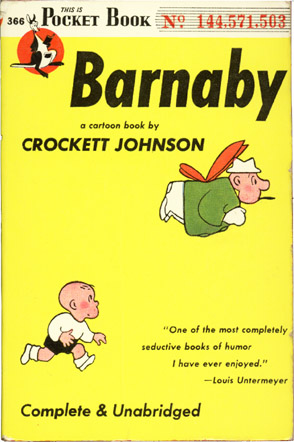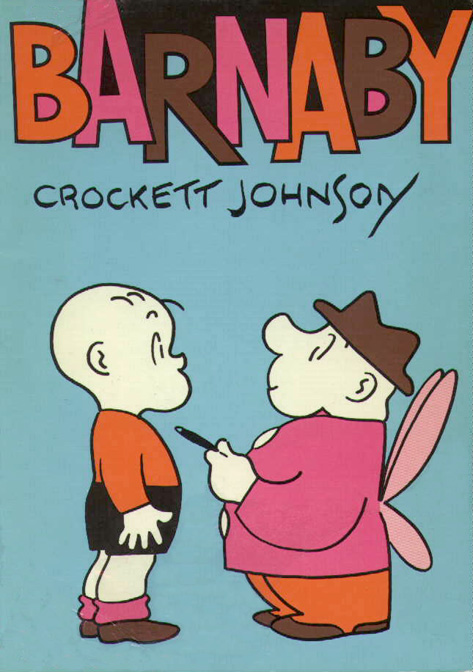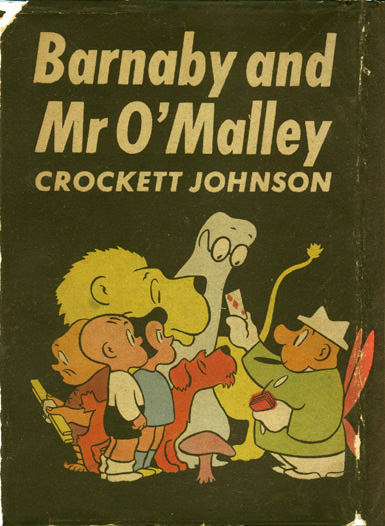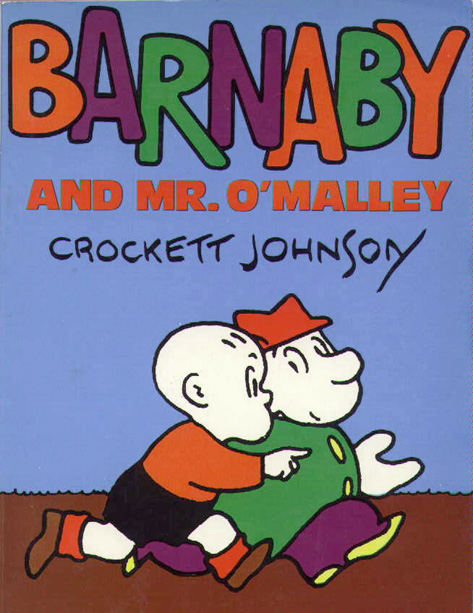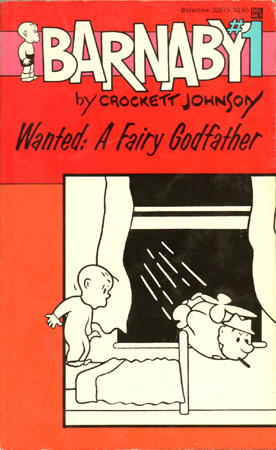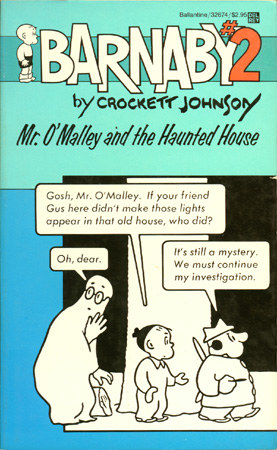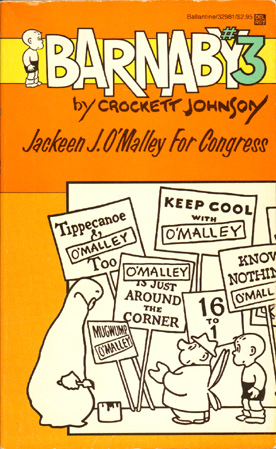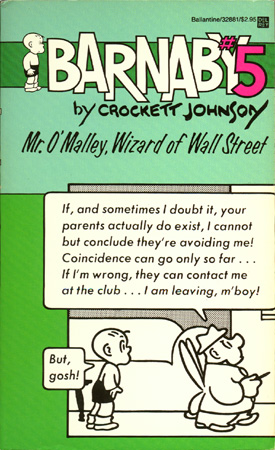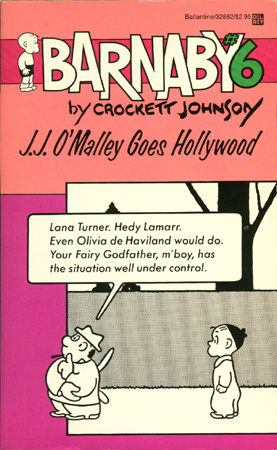Crockett Johnson’s Books: Comics
The Barnaby Books
Barnaby (1943)
This collection introduces Mr. O’Malley to the Baxter family (although only Barnaby believes in his Fairy Godfather). Barnaby and O’Malley visit a child psychologist, appear on the radio, inadvertently undermine a test blackout and expose a “Hot Coffee Ring” (the action takes place during the Second World War, when coffee was rationed). We also meet McSnoyd, Gorgon, Jane, and Gus.
Also available in Italian.
Barnaby and Mr. O’Malley (1944)
With Mr. O’Malley’s help, Barnaby’s Victory Garden doesn’t exactly flourish. They do, however, manage to foil an OPA hold-up and they meet a circus lion, Atlas (the “mental giant”), and Gorgon’s father. The latter portion of the book chronicles Mr. O’Malley’s run for congress, offering sly satire on electoral politics.
Barnaby #1: Wanted, a Fairy Godfather (1985)
Barnaby #s 1-6 are reissues of the original comic strips (as published in PM); these are not the slightly redrawn versions that appear in Barnaby (1943) and Barnaby and Mr. O’Malley (1944). Furthermore, there are more strips included in the six Barnaby volumes (1985-86) than ever were in the original books.
This volume covers the same episodes included in Barnaby, up to Mr. O’Malley’s visit to Jane’s room. In addition to the adventures chronicled in Barnaby, Barnaby #1 also finds Mr. O’Malley being mistaken for a spy plane, and a lot more war-related stories. Overhearing a Nazi’s parrot leads Barnaby to prevent the destruction of a powerhouse; Bilharzia Ogre and Mr. Jones (who bear a striking resemblance to one another) are also in cahoots with the Nazis. Fortunately, Barnaby and Mr. O’Malley intervene….
Barnaby #2: Mr. O’Malley and the Haunted House (1985)
From just before the arrival of Gorgon (an episode found in Barnaby) to the visit with Rover (in Barnaby and Mr. O’Malley), this volume delivers stories from the two books published in the 1940s. But, since it reprints the original PM strips unedited, we are treated to adventures never before published in book form — such as Barnaby and Jane (and O’Malley) at Mrs. Krump’s Kiddie Kamp. Also, there are some subtle textual and narrative variants: in Barnaby and Mr. O’Malley, Gus writes O’Malley’s campaign biography; however, in Barnaby #2, it’s foiling the “Hot Coffee Ring” that prompts O’Malley to want his biography written.
Barnaby #3: Jackeen J. O’Malley for Congress (1986)
After more (mis)adventures at Mrs. Krump’s Kiddie Kamp (such as Mr. O’Malley attempting to teach the children to fly), everyone returns home. Although the tale of Mr. O’Malley’s run for Congress appears in Barnaby and Mr. O’Malley, the earlier book does not include what happened next. Following his election to the House of Representatives, O’Malley is appointed to the Useless Papers Committee — but he spends very little time in Washington itself. In Johnson’s deft satire of the Dies Committee, O’Malley forms the “O’Malley Committee” (consisting of himself, Gus, Barnaby, and Jane) to investigate Santa Claus. After Barnaby receives a Christmas gift of boxing gloves, boxing becomes popular at the Elves, Leprechauns, Gnomes and Little Men’s Chowder & Marching Society: McSnoyd out-boxes O’Malley, and then Gus gets into training to challenge McSnoyd. During and following the “boxing” episode, absentee Congressman O’Malley finally makes an appearance in Washington and helps get the dam bill passed, making him a hero to the people of his district. Though Mr. Baxter’s firm benefits from the bill, he still doesn’t believe that Congressman O’Malley is Barnaby’s Mr. O’Malley. So, O’Malley decides to write “a scholarly, authoritative, anthropological and sociological treatise on Pixies” in order to prove his existence to Barnaby’s parents.
Barnaby #4: Mr. O’Malley Goes for the Gold (1986)
To collect “data on Pixies for my great scientific work,” O’Malley chats with Gridley, the salamander (a “Fire Pixie” whose pipe keeps going out). While Mr. Baxter is sick, Mr. O’Malley goes to help out at the plant. During the summer, the Baxter and the Shultz families stay at Jane’s aunt’s beach house. With the help of Gus (the Ghost) and Davy Jones (“the King of the Sea”), Mr. O’Malley and Barnaby hunt for buried treasure. After returning from the coast, the strip satirizes 1944 Republican candidate Thomas Dewey’s presidential campaign. O’Malley and three ghosts are running Dewey’s campaign. The ghosts are: A.A., a tycoon who has a watch that runs backwards and who wants to return to a pre-war America (an impossible wish); Colonel Wurst, a newspaper publisher who prints newspapers with increasingly older news (to help turn back the clock); and Ex-Senator Ecks, who says very little. During Thanksgiving, we meet J.J. O’Malley’s cousin Myles O’Malley hunting for a turkey; as Christmas approaches, Barnaby’s Fairy Godfather enlists J.P. Orion’s help in hunting ermine (in order to make a wrap as a gift for Barnaby’s mother).
Barnaby #5: Mr. O’Malley, Wizard of Wall Street (1986)
After helping (and hindering) the investigation into the stolen furs, O’Malley decides to produce his own soap opera — the “Grand Opera Soap Opera.” Unable to find a sponsor, he decides to underwrite his own show by “going into trade.” Soon, O’Malley Enterprises, Inc. is the talk of Wall Street; the story of the company’s rise and fall deftly satirizes the speculative nature of the stock market. Jacob “Jake” Marley (formerly a businessman and presently a ghost) visits Gus during this episode. Next, Mr. Baxter takes Barnaby, Jane, and Gorgon on a picnic; while dad sleeps, Mr. O’Malley takes them to meet Emmy Lou Schwartz, “Licensed Witchcraft Practitioner, 98,413.” Although she lives in a gingerbread house, she’s never read Hansel and Gretel. So, Jane loans her copy to Emmy Lou. In the last episode of the book, Barnaby’s Aunt Minerva (an author) comes to stay with the Baxters. Unlike Barnaby’s parents, she finds Barnaby’s references to O’Malley “utterly delightful.” Though she doesn’t meet the elusive Fairy Godfather, he — with the help of printer’s devil Shrdlu — places his recipe in her newspaper column.
Barnaby #6: J.J. O’Malley Goes Hollywood (1986)
When Aunt Minerva decides to rent an apartment from a superstitious landlord, Mr. O’Malley and Gus come to her assistance. After moving in, she decides to throw O’Malley a party, but he has difficulty persuading his friends to come. As Thanksgiving approaches, both the butcher and O’Malley favor venison, but the Baxters want turkey. Howard (an American Indian acquaintance of O’Malley’s), O’Malley, Barnaby, and Jane go off in search of venison. A movie camera (won as a prize) inspires Barnaby’s Fairy Godfather to direct a film; he enlists Gus to adapt The Decline and Fall of the Roman Empire into a screenplay…. Tired of being dismissed as an “imaginary character” by Barnaby’s parents, Mr. O’Malley decides to give a series of lectures on Pixies. During the lecture series, a Refrigerator Bandit visits both the Baxter and Shultz families. In the final episode, Mr. Baxter plays for his office baseball team and, of course, O’Malley insists on lending his expertise.
The last strip of Barnaby #6 is dated 31 May 1946; Johnson had stopped writing them in January 1946 — he was still involved as a story consultant, but Ted Ferro and Jack Morley wrote and illustrated it through August of 1947. In September, Johnson resumed writing the scripts and Morley continued creating the art (from then on, the credit read “Jack Morley and CJ”). Johnson took over in full for the final episode, and the last strip was published on February 2, 1952. So, the Del Rey series leaves out nearly 6 years’ worth of un-anthologized strips. Indeed, if one includes the new “Barnaby” (updated by Johnson and redrawn by Warren Sattler), which ran from September 1960 to April 1962, we could add another year and a half to that figure.
A list of books in Barnaby #4 and Barnaby #5 indicate that volumes beyond #6 were planned (following the final title are the words “AND LOTS MORE TO COME”), but Ballantine stopped with J.J. O’Malley Goes Hollywood. According to “Barnaby Comic Strips to Be in Book Form” (New York Times 18 June 1985: C17) and “The ‘Barnaby’ Books Bring Back the Magic” (Newsweek 29 July 1985), Ballantine originally planned to publish 12. In the Washington Post the following June, Bob Halliday reports, “The republication was the brainchild of Judy-Lynn Del Rey, whose recent death prevented her from seeing the project through to its completion. New generations of Barnaby-ophiles will be grateful to her.” Perhaps, if she had lived longer, volumes 7-12 would have been published, too; but, as Halliday says, we are grateful to Ms. Del Rey for the publication of 1-6.
In January 2000, Comics Revue began republishing the strips from the 1960s; its reprints of the 1960-62 run of “Barnaby” ended in early 2002. The second Little Lit collection, Strange Stories for Strange Children (published in September of 2001), features a “Barnaby” sequence, adapted from Barnaby (1943), pp. 2-8, 10, 13-35, 39-40, and Barnaby and Mr. O’Malley (1944), pp. 2-3.
In 2013, the Barnaby strips finally get the reprint series they deserve. Fantagraphics’ five-volume series (covering the entire ten years of its original run) begins. I serve as co-editor for the series, and provide both notes and an essay for each volume.
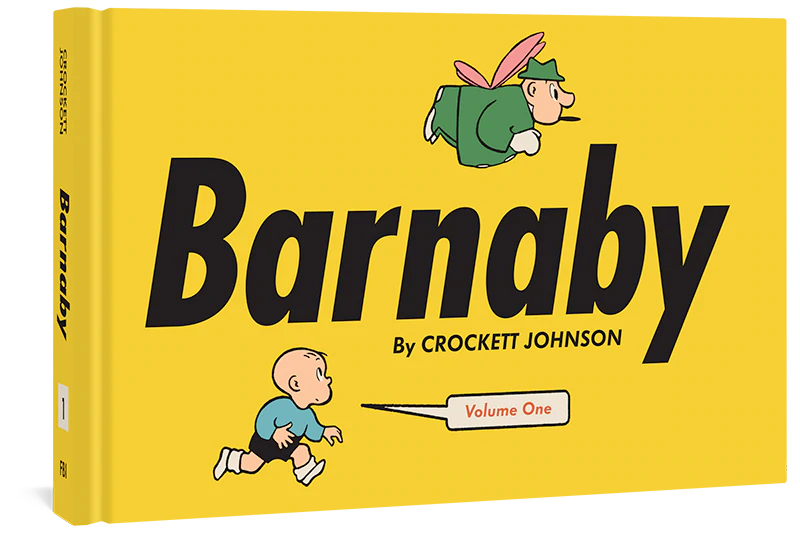
Barnaby Volume One: 1942-1943 (2013). Edited by Philip Nel and Eric Reynolds. Essays by Chris Ware, Jeet Heer, Dorothy Parker. Notes and biographical essay by Nel. Design by Daniel Clowes.
This volume covers the same episodes included in Barnaby and Barnaby and Mr. O’Malley. In addition to those adventures Barnaby Volume One also finds Mr. O’Malley being mistaken for a spy plane, and a lot more war-related stories. Overhearing a Nazi’s parrot leads Barnaby to prevent the destruction of a powerhouse; Bilharzia Ogre and Mr. Jones (who bear a striking resemblance to one another) are also in cahoots with the Nazis. Fortunately, Barnaby and Mr. O’Malley intervene. It also brings us Barnaby and Jane (and O’Malley) at Mrs. Krump’s Kiddie Kamp. Also, there are some subtle textual and narrative variants: in Barnaby and Mr. O’Malley, Gus writes O’Malley’s campaign biography; however, in Barnaby #2, it’s foiling the “Hot Coffee Ring” that prompts O’Malley to want his biography written. Although the tale of Mr. O’Malley’s run for Congress appears in Barnaby and Mr. O’Malley, the earlier book does not include what happened next. Following his election to the House of Representatives, O’Malley is appointed to the Useless Papers Committee — but he spends very little time in Washington itself. In Johnson’s deft satire of the Dies Committee, O’Malley forms the “O’Malley Committee” (consisting of himself, Gus, Barnaby, and Jane) to investigate Santa Claus.
In other words, this book provides all of the Barnaby presented in the first two Del Rey books and part of the third Del Rey book — though Fantagraphics provides larger-sized strips in a much better produced hardback book.
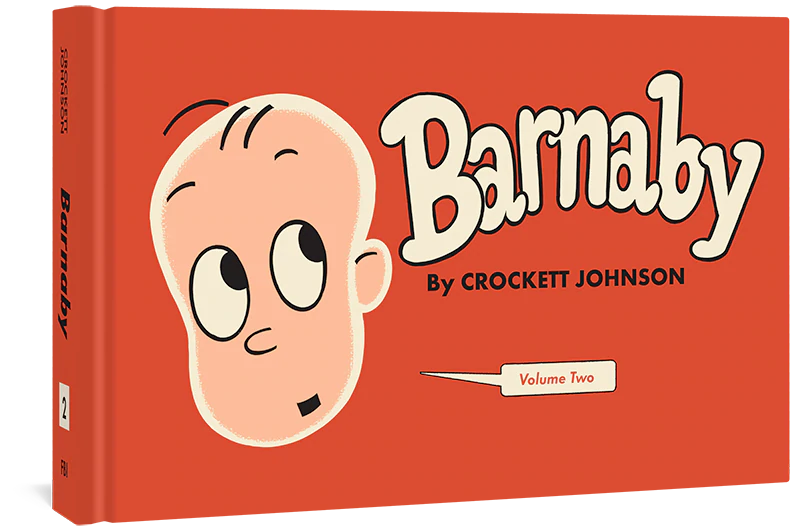
Barnaby Volume Two: 1944-1945 (2014). Edited by Philip Nel and Eric Reynolds. Essays by Jules Feiffer, R.C. Harvey, Max Lerner. Notes and biographical essay by Nel. Design by Daniel Clowes.
This volume covers the boxing enthusiasm among members of the Elves, Leprechauns, Gnomes and Little Men’s Chowder & Marching Society, Congressman O’Malley helping to get a dam bill passed, O’Malley’s aspiration to write “a scholarly, authoritative, anthropological and sociological treatise on Pixies” in order to prove his existence to Barnaby’s parents, O’Malley helping out at the plant while Mr. Baxter is sick, Gus and O’Malley and Barnaby hunting for buried treasure during a summer vacation at Jane’s aunt’s beach house, the discovery that O’Malley and three ghosts are running 1944 Republican candidate Thomas Dewey’s presidential campaign, a Thanksgiving visit with J.J. O’Malley’s cousin Myles O’Malley, Barnaby’s Fairy Godfather and J.P. Orion’s attempts to hunt ermine, the O’Malley Enterprises narrative, a visit to Emmy Lou Schwartz (“Licensed Withcraft Practitioner, 98,413),” Barnaby’s Aunt Minerva coming to stay with the Baxters (which introduces the printer’s devil Shrdlu), and Thanksgiving with Howard (an American Indian acquaintance of O’Malley’s).
In other words, this book provides all of the Barnaby presented in part of the third Del Rey book, all of the fourth and fifth Del Rey books, and part of the sixth Del Rey book. The main difference, of course, is that Fantagraphics provides larger-sized strips in a much better produced hardback book.
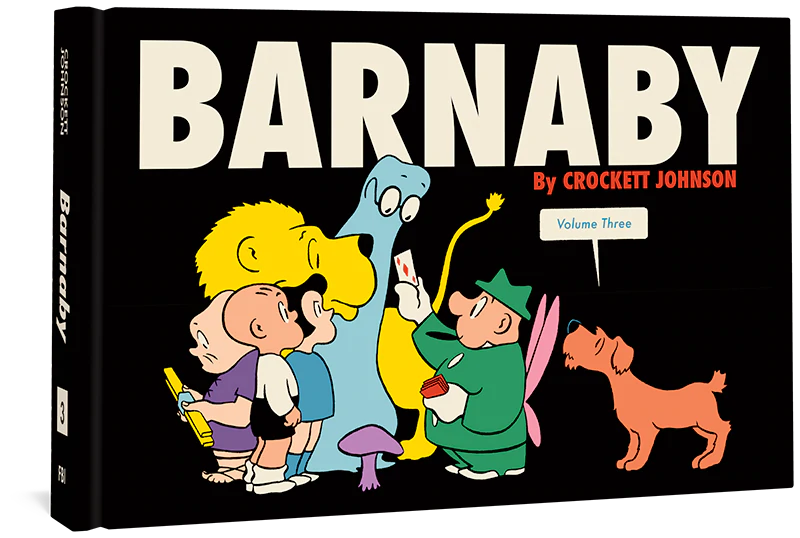
Barnaby Volume Three: 1946-1947 (2016). Edited by Philip Nel and Eric Reynolds. Essays by Jeff Smith, Nathalie op de Beeck, Coulton Waugh. Notes and biographical essay by Nel. Design by Daniel Clowes.
This volume is the first to go beyond the Del Rey paperbacks. It covers the first six months of 1946 (which are in the sixth Del Rey book): A movie camera (won as a prize) inspires Barnaby’s Fairy Godfather to direct a film; he enlists Gus to adapt The Decline and Fall of the Roman Empire into a screenplay. Tired of being dismissed as an “imaginary character” by Barnaby’s parents, Mr. O’Malley decides to give a lecture series on Pixies. Meanwhile, a Refrigerator Bandit visits both the Baxter and Shultz families. In the final episode, Mr. Baxter plays for his office baseball team and, of course, O’Malley insists on lending his expertise. But then it goes into the realm of the uncollected Barnaby, which finds O’Malley proposing a solution to the post-war housing shortage, establishing his own school, explaining atomic power (poorly), and becoming first general from and then UN ambassador for Sylvania.
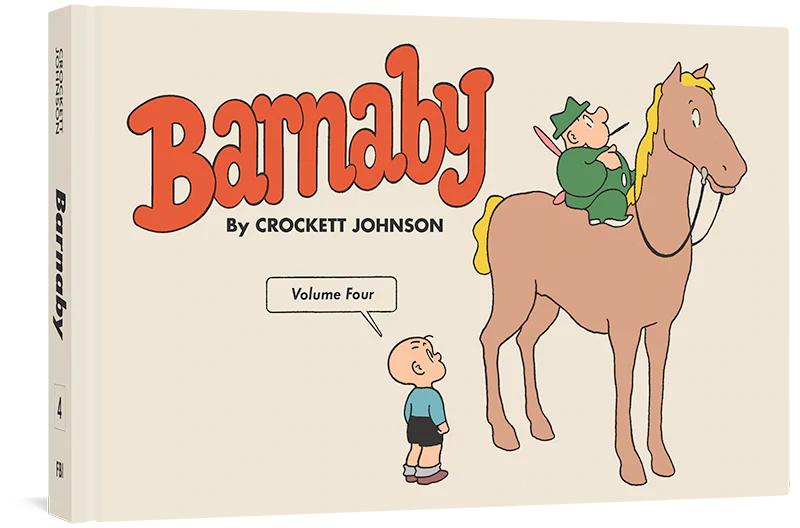
Barnaby Volume Four: 1948-1949 (2020). Edited by Philip Nel and Eric Reynolds. Essays by Trina Robbins, Jared Gardner, Stephen Becker. Notes and biographical essay by Nel. Design by Daniel Clowes.
After concluding the UN/Sylvania narrative, O’Malley decides to go into marketing — creating eyewash, and then producing commercials to sell it. During the summer of 1948, Barnaby’s Fairy Godfather and Gus venture into the theatre, granting Johnson an opportunity to make fun of pretentious dramatists and O’Malley a chance to make a dull play far more interesting. In the fall, O’Malley proposes unusual solutions to the problem of overcrowded schools. After disappearing for half of December, he returns to introduce Barnaby to Jack Frost and then to a dragon. When Barnaby needs his tonsils out, O’Malley draws upon his (dubious) medical expertise in an effort to help. In the remainder of the book, he becomes Barnaby’s art instructor, tries to catch jewelry thieves, and ventures into television production. The volume concludes by beginning to introduce the pixies who make households appliances work.


